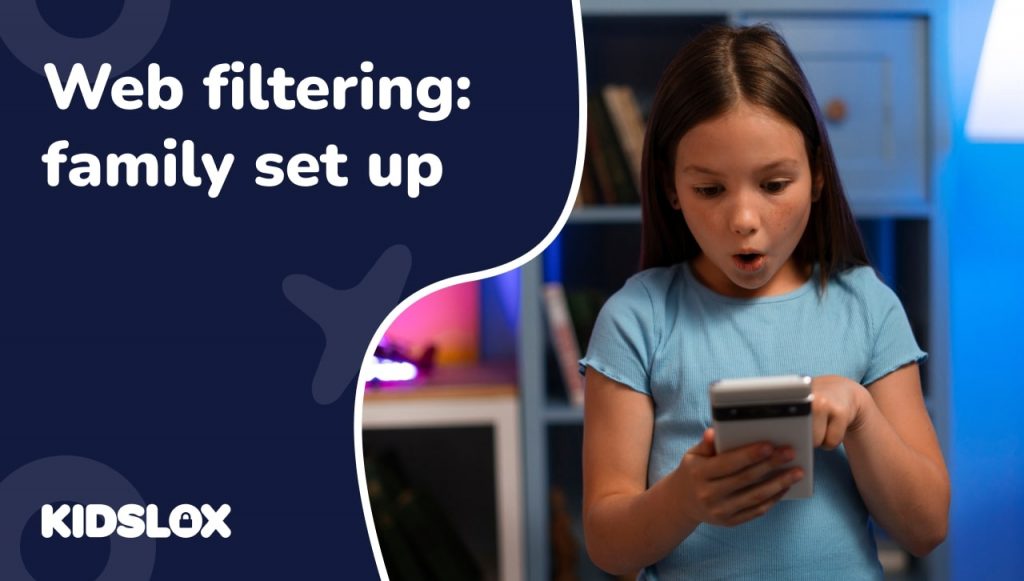The internet has grown to be an integral part of our lives, offering a myriad of information and entertainment options. However, this digital universe can also be a breeding ground for inappropriate content and malicious cyber threats.
This raises a crucial concern, especially for families with young internet users – how can you ensure a safe and secure online environment for your children? And with remote classes, digital dependence is only set to rise.
Web filtering and parental control tools are the best way to protect your family from harmful online content, malware, and more. They allow you to block certain websites or categories of sites, limit internet access times, monitor browsing history, and even view usage reports. With web filters in place, parents can feel confident that their children’s online activities are safe and secure.
In this comprehensive guide, we’ll explore the concept of web filtering, its importance, and how parents can effectively set up web filters for a safer family internet experience.
What is Web Filtering?
Web filtering is a technique used to restrict or control the content a user can access on the internet. It works by categorizing websites and web pages based on their content and then restricting access to those categories deemed inappropriate.
Web filtering software or a web filtering app can be installed on individual devices or applied across an entire network, depending on the needs and preferences of the user. These tools use various mechanisms to classify and filter content, including:
- URL Filtering: This method blocks access to specific websites by their URL or domain name. Think of it like a “blacklist” for the web.
- Keyword Filtering: This approach blocks websites containing specific keywords deemed inappropriate or harmful -even those that may seem harmless.
- Category-Based Filtering: This technique classifies websites into predefined categories (like adult content, violence, gambling) and blocks access to those categories as per the user’s preference.
- Dynamic Content Analysis: This method analyzes the page’s actual content in real-time to determine if it should be blocked, even if the site itself is not on a blacklist. While this is a more precise approach, it can also be very resource-intensive.
These methods can be used individually or in combination to create a secure online environment, making web filtering a versatile and robust tool for internet safety. However, determining which approach is best for a given situation requires careful consideration of the desired outcome, potential risks, and available resources.
It’s also important to understand that no single solution can provide comprehensive protection; instead, creating an integrated strategy involving multiple layers of defense is important.
Why is Web Filtering Important for Families?
With the increasing number of young internet users, web filtering has become a vital tool for families. Here’s why:
Child Safety Is Paramount In The Online Age
Web filtering helps protect children from exposure to harmful or inappropriate content such as pornography, violence, hate speech, and cyberbullying. You can also control access to social media and gaming sites, helping your child stay focused on schoolwork.
Reduce Risk Of Identity Theft And Fraud
Identity theft is a growing concern for families, particularly those with older children who may already have their own devices or accounts. By implementing web filtering, you can help protect against phishing scams and data breaches that could lead to identity theft.
Protect Devices From Malware & Viruses
Infected websites and malicious downloads can lead to costly repairs or replacements of devices. Web filtering helps prevent access to sites that deliver malware, ensuring your family’s devices remain safe and secure.
Productivity Enhancement
It’s not all bad news: web filtering can also be used to your advantage. By blocking access to certain websites and applications, you can help increase productivity when it comes to schoolwork and other important tasks. Put a timer on the filter if you need to further limit distractions – just set a time limit that’s appropriate for each household member or activity.
The Risks of Inappropriate Content: What Parents Should Know
With the vastness of the internet, children can easily stumble upon content unsuitable for their age. This inappropriate content can take various forms, including:
- Explicit Sexual Material: This includes pornography and explicit music videos.
- Violent Content: Graphic images or descriptions of violence can be disturbing for young minds.
- Hate Speech and Cyberbullying: Content that incites hatred or promotes bullying can negatively impact a child’s mental health.
- False or Misleading Information: The internet is rife with misinformation and propaganda, which can manipulate a child’s understanding of the world.
- Malware and Scams: Some websites may trick children into downloading malicious software or falling for scams.
Given these potential dangers, it’s crucial for parents to take steps to limit their child’s access to such material. And with smartphones in the hands of more and more children, the digital world is now more accessible than ever. Parents should be aware of what their children can access online and take steps to ensure that they remain safe.
How to Set Up Web Filtering for Family Use
Now that we’ve understood what web filtering is and why it’s essential, let’s delve into how you can set up web filters for your family.
Setting Up Web Filtering on Parental Control Software
Parental control software provides a comprehensive solution to manage and monitor your child’s online activities. One of the most effective web filtering software available today is Kidslox. With Kidslox, you can:
- Block Inappropriate Websites: Kidslox blocks over five million inappropriate URLs by default and allows parents to manually add any additional websites they find unsuitable.
- Limit Internet Access: Parents can disable Internet access for certain periods, like during homework or bedtime, to ensure that screen time doesn’t interfere with other vital activities.
- Monitor Online Activities: Kidslox provides daily reports and real-time notifications about your child’s online activities, helping you closely monitor their internet use.
As one of the best ways to gain greater control over your children’s online activities, third-party parental monitoring apps ca help parents keep their children safe. Plus, you can fine-tune the settings as they grow – ensuring they’re always protected from the dangers of the internet.
Setting Up Web Filtering on Google Chrome and Other Browsers
Browser-based web filtering can help protect children from accessing inappropriate content online. Google Chrome allows parents to set up supervised accounts, which are managed through Family Link.
For families that primarily use Google Chrome for internet browsing, here’s how you can set up web filtering:
- Open Google Chrome and go to ‘Settings’.
- Under ‘People’, click on ‘Manage Other People’.
- Here, you can create a supervised profile for your child. This profile will have restricted access to the websites you deem inappropriate.
Similarly, Safari and Mozilla Firefox also offer parental controls and web filtering options. Parents can choose to block certain websites, monitor web activity, or set up time limits in order to manage their kids’ internet usage.
Using DNS-Level Filtering
DNS-level filtering is another effective method of web filtering – albeit, the most intensive and in-depth of all the options.
It involves setting up a unique domain name server (DNS) that blocks websites based on their URL addresses. Services like OpenDNS or Google Public DNS can be used to set up DNS filtering. When this is enabled, all requests for blocked websites will be redirected to a “blocked” page with an explanation of why the content has been restricted.
Remember, while DNS filtering is effective, it requires a fair understanding of network settings and may not be the most user-friendly solution for everyone. You could inadvertently block legitimate content while trying to restrict access to unwanted sites. This should be used with caution and only as a last resort for controlling inappropriate content.
Teaching Kids about Safe Internet Usage
While web filters play a crucial role in protecting children from harmful content, it’s equally important to educate them about safe Internet usage. Here are a few tips that can help kids learn how to stay safe online:
- Open Communication: Have open and honest discussions with your child about the potential dangers of the internet. Make sure they understand why certain types of content are inappropriate or harmful.
- Teach Them About Privacy: Explain the importance of not sharing personal information online and the risks associated with it.
- Encourage Critical Thinking: Teach your kids to question and critically evaluate the information they come across online.
- Set Clear Rules: Establish clear internet usage rules, such as screen time limits, approved websites, and online behaviors.
Safeguard Your Family’s Online Experience with Web Filtering
The internet can be a treasure trove of information and a great tool for education and entertainment. However, it’s crucial to ensure this resource is used safely and responsibly, especially by young users. Web filtering offers an effective solution to protect your kids from inappropriate content and make their online experience safer.
Remember, setting up web filters is just the first step. Continual monitoring, open communication, and education about safe internet practices are equally important to ensure your child’s digital wellbeing. Tools like Kidslox make this task easier, providing comprehensive parental controls for a safer and healthier online environment.
Ensure a safer browsing experience for your family today by setting up web filters and promoting responsible internet usage. It’s an investment in your child’s safety and peace of mind. Want to learn more? Check out our resources for parents, and add Kidslox for an extra layer of safety! Together we can make the online world a safer place for everyone.





